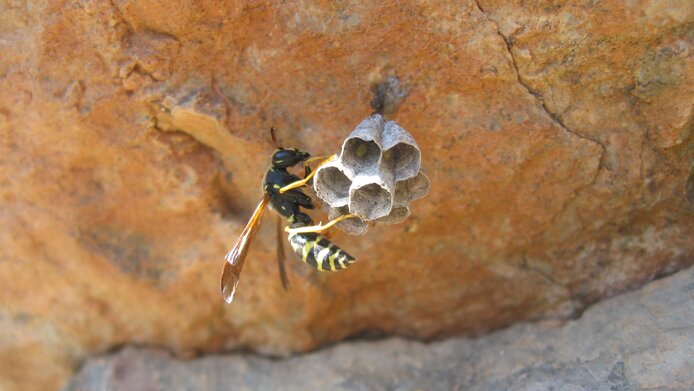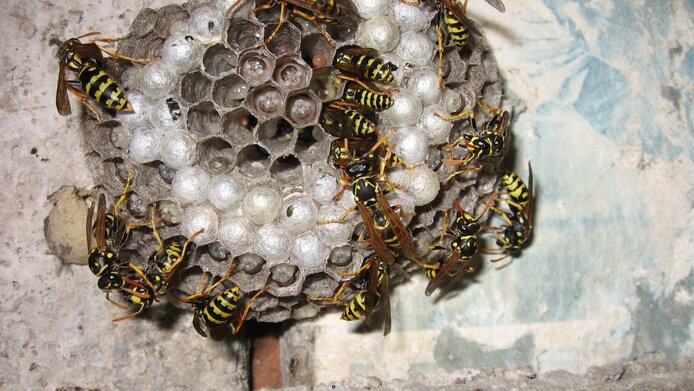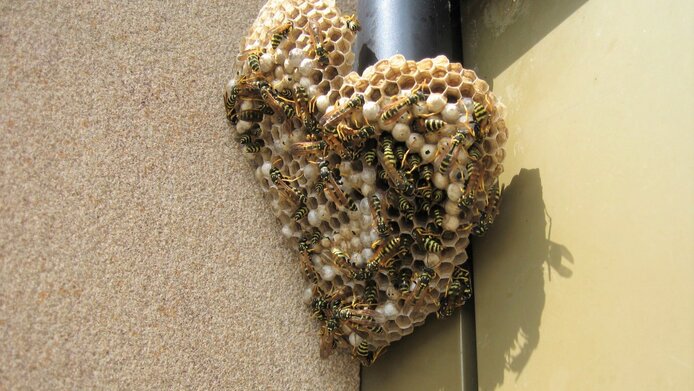Will the wasps be able to stand the heat?

It was in 2019 that the topic started to be discussed in the public arena: international studies reported an unprecedented global extinction of insects. On average, the number of insects is dropping by almost ten percent per decade, and up to 40 percent of species could become extinct within the next few decades. There are many reasons for this phenomenon. Land use and the use of pesticides are important factors, but the exact nature of the mechanisms is still poorly understood. In particular, there is still a lack of clarity about how insects react to the rise in temperature caused by climate change. In a project funded by the Austrian Science Fund FWF, a group headed by the biologist Helmut Kovac has now examined in greater detail the energy metabolism of several wasp species as a function of ambient temperature.
Wasps as a model
The Graz-based team is focusing on the paper wasp (genus Polistes), which is well suited as a model organism, according to principal investigator Kovac: “In contrast to the common wasps we all know, paper wasps build relatively small nests with a maximum of up to 100 individuals. The nests have open combs, which makes them easy to observe for behavioural studies.” Paper wasps are also special in terms of regulating their body temperature. While a distinction is made in vertebrates between warm-blooded and cold-blooded animals – endotherms and ectotherms – there is not such a clear dividing line in insects. “Paper wasps are a kind of intermediate stage among insects. Bees are able to actively raise their body temperature to up to 45 degrees. Paper wasps, on the other hand, are ectotherms most of the time, but are indeed capable of raising their body temperature when flying, foraging or attacking enemies,” Kovac explains. This property recommends them for research into various aspects of body temperature regulation.
Wasps with different habitats
For their research, Kovac’s team selected three of the approximately 15 European species of paper wasps. “All of these species originally came from the south, from warmer regions,” Kovac notes. The most widely known among them is the European paper wasp, Polistes dominula, which is very common in our country and very adaptable and has also been distributed to other continents, where it spreads invasively. “In addition we investigated a sister species, Polistes gallicus, whose distribution is restricted to the Mediterranean region,” Kovac elaborates. The third species chosen was a mountain wasp that only lives at altitudes above 1000 metres and is also related to the others.
Kovac wanted to find out how much energy the animals consume. To this end, the research team monitored how much CO2 the animals emitted. They did this in much the same way as is done in human fitness checks, where the individual’s respiratory gas is collected and evaluated during sessions on the ergometer. The researchers locked the wasps into airtight glass tubes and measured the amount of CO2 produced inside. “In addition, we observed the animals in their habitat with video and infrared cameras,” Kovac points out. These recordings were later evaluated in order to determine exactly how active the animals were and what their body temperature was.
Energy demand increases with temperature
The researchers learned that higher ambient temperature leads to a strong increase in the energy metabolism of the insects. “We observed an exponential correlation between ambient temperature and energy consumption,” Kovac reports. While this correlation was almost the same for the European paper wasp from Austria and the Mediterranean species from Italy, the wasps native to the mountains showed a much more reduced energy demand. “We attribute this to the fact that the alpine wasps are limited in their ability to forage for food owing to the lower outdoor temperature,” says Kovac. Because paper wasps prefer to live in ectothermic mode, their body temperature at rest is identical to the outside temperature. Honey bees or other wasps, on the other hand, can readily raise their body temperature and are thus independent of the temperature outside.
“For paper wasps, the temperature has to be at least 20 degrees centigrade for them to fly and forage,” Kovac notes. Hence, a higher outdoor temperature has several consequences. The animals can fly out more often, but they also have to collect more food to cover the higher energy consumption. It is therefore impossible to make a simple forecast of the effects of global warming, as the various factors have to be weighed against each other. “It is our aim to devise a model that allows us to ask and answer specific questions,” Kovac explains. “What is the total amount of energy consumed by one insect during its lifetime? How much does a colony need during a breeding season under specific climatic conditions?”
Queens need fat reserves
The wasps one encounters out in the open are usually worker wasps – Kovac calls them “summer wasps” because they die in the autumn. The queens are the only ones to live through the winter and start a new colony in spring. For hibernation, they build up fat reserves in the autumn. After their studies on summer wasps, Kovac's team specifically examined the queens and measured their energy consumption. Again, differences emerged: “We saw that the Mediterranean species has a lower basal metabolism than the common paper wasp that is native to our region.” This was an unexpected insight about this species. “We suspect the reason to be that the mean temperature in winter is higher in the south,” Kovac assumes. In order to compensate for the increased metabolic activity due to the higher temperature, they had to lower their basic metabolism over millions of years in evolutionary adaptation so that they could get through the winter with the fat reserves they had available.
“The question is whether the species will have enough fat reserves when temperatures rise,” Kovac points out. Investigations into this issue are still ongoing as the team is currently evaluating the data collected on fat metabolism and the microclimatic conditions in the queens' hibernation sites. The FWF-funded project, on which Kovac worked with his colleagues Helmut Käfer and Anton Stabentheiner, ran for three and a half years and was completed in 2020. In a follow-up project, the research team intends to examine more closely breeding behaviour as well as larvae and pupae.
Cooperation with climate research
Kovac points out that it is still difficult to make precise statements about threat scenarios for insects that are due to climate change. “You actually have to analyse each species in detail. At this point we cannot really say which species are endangered and how,” Kovac notes. Not only interesting as a model organism, the wasps also play an important role – often underestimated – in the domestic ecosystem by eating the larvae of moths and similar animals, which makes them beneficial to agriculture. Kovac's findings on metabolism are designed to serve as the basis for research partnerships with groups specialising in climate research. “Then we will be able to make more accurate predictions about which species are endangered, and which species might even benefit from higher temperatures,” Kovac hopes.
Personal details
Helmut Kovac is conducting research at the Institute of Biology (University of Graz) in the ecophysiology unit. He is interested in thermobiology, energy metabolism and respiration in insects, especially wasps and bees. The three-year basic research project “The impact of climate change on the energetics of primitively eusocial paper wasps” received funding in the amount of roughly EUR 350,000 from the Austrian Science Fund FWF.
Publications
Helmut Kovac, Bettina Kundegraber, Helmut Käfer et al.: Relation between activity, endothermic performance and respiratory metabolism in two paper wasps: Polistes dominula and Polistes gallicus, in: Comparative Biochemistry and Physiology Part A: Molecular & Integrative Physiology, Vol. 250, 2020
Helmut Kovac, Helmut Käfer, Anton Stabentheiner: The Respiratory Metabolism of Polistes biglumis, a Paper Wasp from Mountainous Regions, in: Insects 2020
Helmut Kovac, Helmut Käfer, Anton Stabentheiner: The Thermoregulatory Behavior of Nectar Foraging Polistine Wasps (Polistes dominula and Polistes gallicus) in Different Climate Conditions, in: Insects 2019
Helmut Kovac, Helmut Käfer, Iacopo Petrocelli, Anton Stabentheiner: Comparison of thermal traits of Polistes dominula and Polistes gallicus, two European paper wasps with strongly differing distribution ranges, in: Journal of Comparative Physiology B 2017







